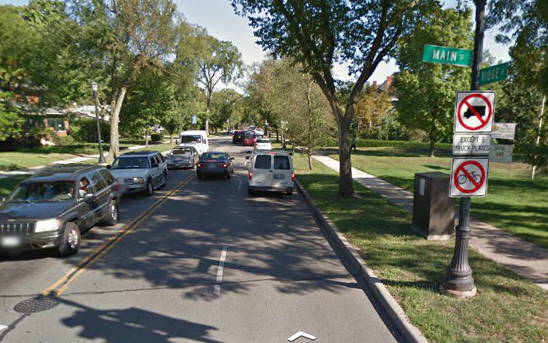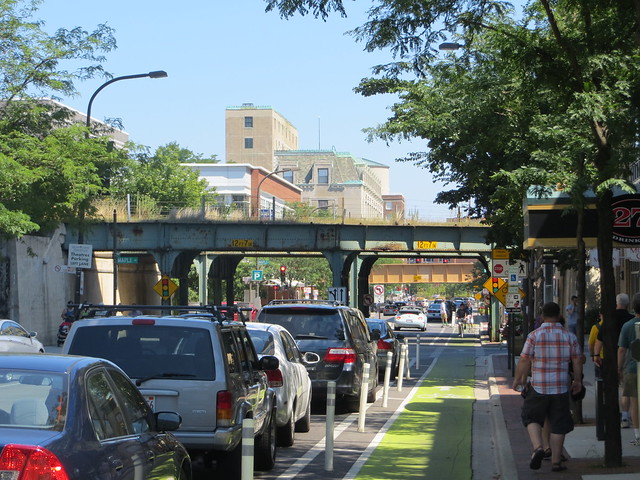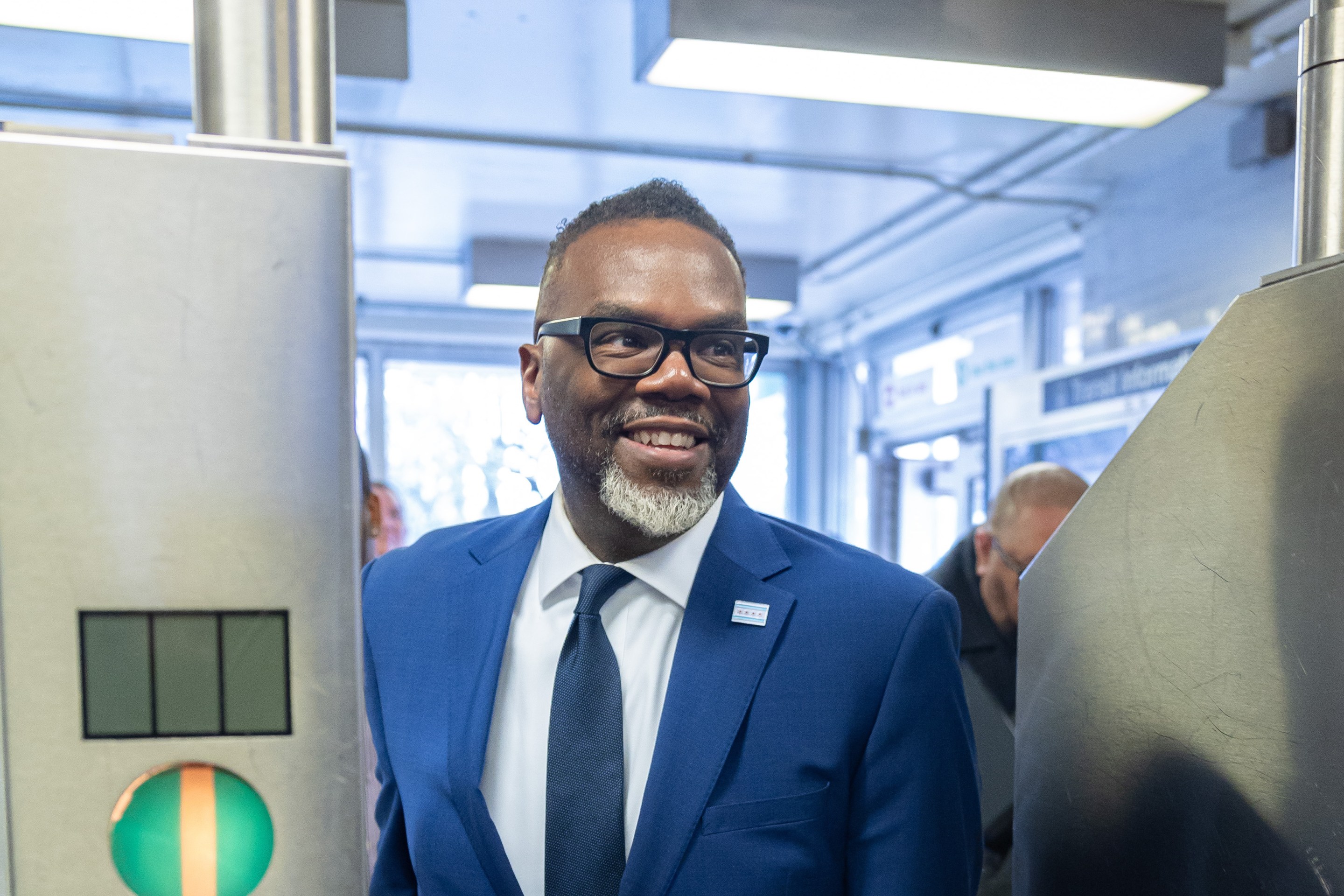
Evanston has a reputation as one of Chicagoland’s most progressive suburbs. That could change if the city’s bike plan update, intended to encourage more pedaling, takes the counterproductive step of recommending banning bikes on some streets. Earlier this month, a public input session for the plan left many locals distressed about the possibility of the city “restricting” cycling on segments of some roads.
That would be an odd future for what’s currently one of the region’s most bike-friendly ‘burbs. Evanston already has high-quality protected bike lane lanes on Church and Davis downtown. Last year the city won a $480,000 state grant to build new PBLs connecting the existing ones to the Chicago border via Dodge, as well as to install bike racks and lockers.
In April, the state granted Evanston another $1.4 million to build on-street protected lanes and/or off-street paths connecting downtown to Wilmette. “So you’ll be able to go all the way from Wilmette to Chicago on protected routes,” said Suzette Robinson, Director of Public Works. The new bikeways should be completed in 2015.

Since October, the city and consultant T.Y. Lin International have hosted several meetings to gather feedback from residents about current conditions for cycling and what changes are needed to create a better biking environment. “Our bike traffic has doubled, so we’re trying to ensure that we don’t have an increase in crashes,” said Robinson. “Our goal is to have a complete streets network where all modes respect each other.”
At the recent meeting, city and T.Y. Lin staffers presented a draft of the plan to residents. To collect additional feedback, a new online survey will launch on Monday, continuing until June 20, and staffers will talk with local employers and buttonhole shoppers in the retail districts, Robinson said. After the input is collected, Public Works may present a final plan to the City Council in July.
During the first part of the meeting, the planners discussed the results of an earlier survey that asked residents how comfortable they are sharing the roads with cars, and how drivers respond to them. Next, the meeting covered potential improvements to Evanston’s more bike-friendly corridors, including strategies to improve safety on these streets, and to better link up the north, south, east, and west sections of town. Here’s a list of the streets identified as “Comfortable Corridors”:
- Corridor 1: Chicago and Hinman (Howard to Church)
- Corridor 2: Howard (Chicago to McCormick)
- Corridor 3: Asbury and Green Bay (Church to Isabella)
- Corridor 4: Maple, Noyes, and Sherman (Grove to Central)
- Corridor 5: Greenleaf (Sheridan to McDaniel)
- Corridor 6: Oakton, Callan, and South (Sheridan to McCormick)
- Corridor 7: Sheridan and Edgemere Court (South to Lee)
- Corridor 8: Lincoln, Harrison, and Lincolnwood (Sheridan to Crawford)
In the final segment of the meeting, participants were surveyed via keypad polling about “High-Stress Corridors.” These included truck routes, streets and intersections with high crash rates, uncomfortably narrow roadways, streets with high parking turnover, as well as streets where state jurisdiction makes it challenging to implement bike improvements. Here are the High-Stress Corridors along with proposed alternative routes:
- Main: McCormick to Hinman. Alternative: Greenleaf, Lee
- Dempster: McCormick to Hinman. Alternative: Greenleaf, Greenwood
- Central: Lincolnwood to Green Bay. Alternative: Lincoln
- Green Bay: Lincoln to Isabella. Alternative Route: Poplar, Prairie, Ashland
- Chicago Avenue: South Blvd to Dempster. Alternative: Hinman
Many attendees were alarmed that the survey brought up the idea of banning biking on problematic streets, instead of making them safer. Sample question: “Based on the factors that identify it as a stressful corridor, do you support restricting bicycling [on X street from Y to Z]?”
This resembled the reasoning behind the 1958 city Council Decision that banned cyclists from Ridge in Evanston, a prohibition that’s still in effect. During the current planning process, community members have voiced support for reconfiguring Ridge, a relatively narrow four-lane street, to allow for safe bike access. It’s obvious that banning cycling from additional streets would be a backwards pedal stroke for a city whose stated goal is to get more people on bikes.
Some council members have said as much. Downtown Alderman Don Wilson said he opposes any additional restrictions on cycling in the city. 9th Ward Alderman Coleen Burrus, a member of the city’s bike planning committee, also said she was not in support of banning bikes from streets unless there truly is no practical option for making a street safer.
Shortly after the meeting, DePaul public policy professor Hugh Bartling tweeted his incredulity that Evanston is even considering bike bans:
How will the @CityofEvanston plan for bike safety? Apparently by banning bikes from commercial districts. http://t.co/FLyAwGk7OA #bikechi
— hughbartling (@hughbartling) May 5, 2014
Robinson defended the inclusion of the bike ban questions in the survey. “The city is not making any recommendations here,” she insisted. “This is not an anti-bike plan. We want to establish more harmony between bicyclists, pedestrians, and drivers.”
It’s disappointing that Public Works, which is otherwise doing a great job of promoting cycling, hasn’t ruled out this “fighting for peace” strategy. Fortunately it’s not too late to voice your opposition. Be sure to fill out the upcoming survey to let them know that further restrictions on biking won't make Evanston safer.





